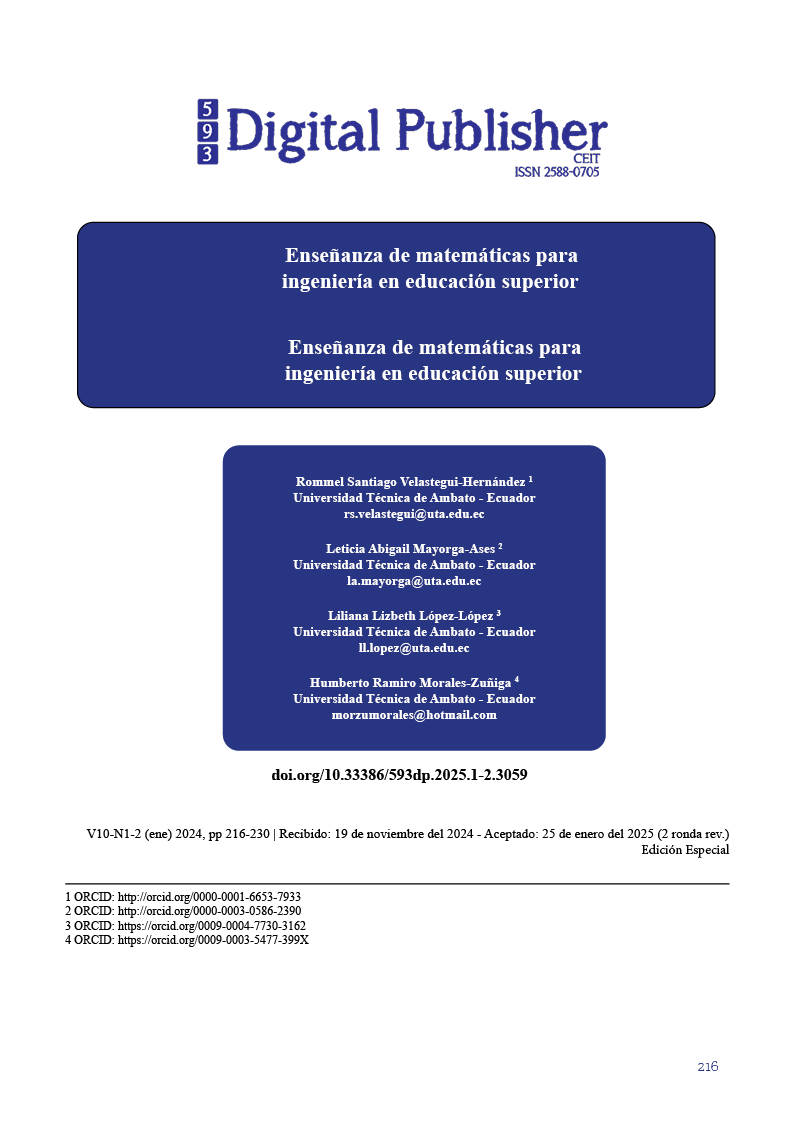Enseñanza de matemáticas para ingeniería en educación superior
Contenido principal del artículo
Resumen
Este estudio analiza la efectividad de diferentes metodologías de enseñanza de las matemáticas en la formación de ingenieros, enfocándose en el rendimiento académico y la motivación de los estudiantes. Se compararon tres enfoques: enseñanza tradicional, aprendizaje basado en problemas (ABP) y el uso de tecnología en el aula. A través de una metodología mixta, se recopilaron datos cuantitativos mediante exámenes y encuestas estructuradas, y cualitativos mediante entrevistas semiestructuradas y observaciones participativas. Los resultados cuantitativos mostraron que el grupo ABP experimentó una mejora del 23% en el rendimiento académico, el mayor aumento entre los grupos, lo que sugiere que el enfoque basado en problemas favorece la comprensión y aplicación de las matemáticas en contextos reales de ingeniería. Los estudiantes del grupo ABP también reportaron mayores niveles de motivación y satisfacción en comparación con los de la enseñanza tradicional, que se caracterizó por una mayor desconexión entre la teoría matemática y su aplicabilidad. Los resultados cualitativos corroboraron estos hallazgos, destacando que la enseñanza tradicional resultó en un bajo nivel de participación y engagement, mientras que el ABP promovió un aprendizaje más activo y colaborativo.
Descargas
Detalles del artículo

Esta obra está bajo una licencia internacional Creative Commons Atribución-NoComercial-CompartirIgual 4.0.
1. Derechos de autor
Las obras que se publican en 593 Digital Publisher CEIT están sujetas a los siguientes términos:
1.1. 593 Digital Publisher CEIT, conserva los derechos patrimoniales (copyright) de las obras publicadas, favorece y permite la reutilización de las mismas bajo la licencia Licencia Creative Commons 4.0 de Reconocimiento-NoComercial-CompartirIgual 4.0, por lo cual se pueden copiar, usar, difundir, transmitir y exponer públicamente, siempre que:
1.1.a. Se cite la autoría y fuente original de su publicación (revista, editorial, URL).
1.1.b. No se usen para fines comerciales u onerosos.
1.1.c. Se mencione la existencia y especificaciones de esta licencia de uso.
Citas
Adams, D. M., McLaren, B. M., Durkin, K., Mayer, R. E., Rittle-Johnson, B., Isotani, S., & Van Velsen, M. (2014). Using erroneous examples to improve mathematics learning with a web-based tutoring system. Computers in Human Behavior, 36, 401–411. https://doi.org/10.1016/j.chb.2014.03.053
Albay, E. M., & Eisma, D. V. (2025). Using design thinking for developing pre-service teachers’ creativity in designing teaching plans to promote interactive learning in mathematics. Learning and Instruction, 96, 102070. https://doi.org/10.1016/j.learninstruc.2024.102070
Arteaga-Briones, L. A., Azúa-Arteaga, A. A., & López-Padrón, A. (2023). Modelo para seguimiento de graduados: Hacia el aseguramiento de la calidad de la Educación Superior ecuatoriana. Revista de Ciencias Sociales, 29(3), 264–279. https://doi.org/10.31876/RCS.V29I3.40711
Bahr, P. R. (2008). Does mathematics remediation work?: A comparative analysis of academic attainment among community college students. Research in Higher Education, 49(5), 420–450. https://doi.org/10.1007/s11162-008-9089-4
Bernsteiner, A., Haagen-Schützenhöfer, C., & Schubatzky, T. (2025). Teacher Education in the Age of Digitality: Conclusions From a Design-Based Research Project. European Journal of Education, 60(1), e12904. https://doi.org/10.1111/ejed.12904
Blotnicky, K. A., Franz-Odendaal, T., French, F., & Joy, P. (2018). A study of the correlation between STEM career knowledge, mathematics self-efficacy, career interests, and career activities on the likelihood of pursuing a STEM career among middle school students. International Journal of STEM Education, 5(1), 22. https://doi.org/10.1186/s40594-018-0118-3
Castronovo, J., & Göbel, S. M. (2012). Impact of high mathematics education on the number sense. PloS One, 7(4), e33832. https://doi.org/10.1371/journal.pone.0033832
Devine, A., Fawcett, K., Szucs, D., & Dowker, A. (2012). Gender differences in mathematics anxiety and the relation to mathematics performance while controlling for test anxiety. Behavioral and Brain Functions, 8, 33. https://doi.org/10.1186/1744-9081-8-33
Ely, M., Magíster, B. /, & Ferruzola, E. (2015). Los Sistemas de información gerencial: aplicabilidad en procesos empresariales y de educación superior en el Ecuador. SATHIRI, 8, 136–149. https://doi.org/10.32645/13906925.402
Faber, J. M., Luyten, H., & Visscher, A. J. (2017). The effects of a digital formative assessment tool on mathematics achievement and student motivation: Results of a randomized experiment. Computers and Education, 106, 83–96. https://doi.org/10.1016/j.compedu.2016.12.001
Fuligni, A. J. (1997). The Academic Achievement of Adolescents from Immigrant Families: The Roles of Family Background, Attitudes, and Behavior. Child Development, 68(2), 351–363. https://doi.org/10.1111/j.1467-8624.1997.tb01944.x
George-Reyes, C. E., López-Caudana, E. O., & Gómez-Rodríguez, V. G. (2024). Communicating educational innovation projects in Latin America mediated by the scaling of complex thinking: Contribution of the UNESCO-ICDE Chair in Mexico. Online Journal of Communication and Media Technologies, 14(3), e202434. https://doi.org/10.30935/ojcmt/14623
Guo, J., Marsh, H. W., Parker, P. D., Morin, A. J. S., & Yeung, A. S. (2015). Expectancy-value in mathematics, gender and socioeconomic background as predictors of achievement and aspirations: A multi-cohort study. Learning and Individual Differences, 37, 161–168. https://doi.org/10.1016/j.lindif.2015.01.008
Hernández, R. S. V., López, G. A. A., Ases, M. J. M., & Dávila, C. A. H. (2023). Gestión educativa de la recreación infantil para escolares. ConcienciaDigital, 6(4), 193–208. https://doi.org/10.33262/concienciadigital.v6i4.2701
Hwang, G. J., Wang, S. Y., & Lai, C. L. (2021). Effects of a social regulation-based online learning framework on students’ learning achievements and behaviors in mathematics. Computers and Education, 160, 104031. https://doi.org/10.1016/j.compedu.2020.104031
Ingersoll, R. M., & Perda, D. (2010). Is the supply of mathematics and science teachers sufficient? American Educational Research Journal, 47(3), 563–594. https://doi.org/10.3102/0002831210370711
Jang, S. J., & Tsai, M. F. (2012). Exploring the TPACK of Taiwanese elementary mathematics and science teachers with respect to use of interactive whiteboards. Computers and Education, 59(2), 327–338. https://doi.org/10.1016/j.compedu.2012.02.003
Kay, R., & Kletskin, I. (2012). Evaluating the use of problem-based video podcasts to teach mathematics in higher education. Computers and Education, 59(2), 619–627. https://doi.org/10.1016/j.compedu.2012.03.007
Lai, C. L., & Hwang, G. J. (2016). A self-regulated flipped classroom approach to improving students’ learning performance in a mathematics course. Computers and Education, 100, 126–140. https://doi.org/10.1016/j.compedu.2016.05.006
Lara Satán, A. A., Satán, N. L., Velastegui Hernández, R. S., & Pullas Tapia, P. S. (2020). Organization and management in the prevention of occupational psychosocial risks in urban public transport. Universidad y Sociedad, 12(4).
Laursen, S. L., & Rasmussen, C. (2019). I on the Prize: Inquiry Approaches in Undergraduate Mathematics. International Journal of Research in Undergraduate Mathematics Education, 5(1), 129–146. https://doi.org/10.1007/s40753-019-00085-6
Lewis, K. L., Stout, J. G., Finkelstein, N. D., Pollock, S. J., Miyake, A., Cohen, G. L., & Ito, T. A. (2017). Fitting in to move forward: Belonging, gender, and persistence in the physical sciences, technology, engineering, and mathematics (pSTEM). Psychology of Women Quarterly, 41(4), 420–436. https://doi.org/10.1177/0361684317720186
Lubienski, S. T. (2000). Problem solving as a means toward mathematics for all: An exploratory look through a class lens. Journal for Research in Mathematics Education, 31(4), 454–482. https://doi.org/10.2307/749653
Megreya, A. M., Hassanein, E. E. A., Al-Emadi, A. A., & Szűcs, D. (2025). Math anxiety mediates the association between gender and STEM-related attitudes: Evidence from a large-scale study. Acta Psychologica, 253, 104689. https://doi.org/10.1016/j.actpsy.2025.104689
Mulenga, E. M., & Marbán, J. M. (2020). Is covid-19 the gateway for digital learning in mathematics education? Contemporary Educational Technology, 12(2), 1–11. https://doi.org/10.30935/cedtech/7949
Naranjo, J. E., Caiza, G., Velastegui, R., Castro, M., Alarcon-Ortiz, A., & Garcia, M. V. (2022). A Scoping Review of Pipeline Maintenance Methodologies Based on Industry 4.0. Sustainability 2022, Vol. 14, Page 16723, 14(24), 16723. https://doi.org/10.3390/SU142416723
Rohenroth, D., Neumann, I., & Heinze, A. (2025). Erratum to: Conceptions of High School Students About the Relevance of Mathematics in Higher Education—their General Perspective and Their Views About Specific Mathematical Requirements (Journal für Mathematik-Didaktik, (2024), 45, 2, (26), 10.1007/s13138-024-00252-6). Journal Fur Mathematik-Didaktik, 46(1), 2. https://doi.org/10.1007/s13138-024-00254-4
Serrano de Moreno, M. S., Castellanos Herrera, S. J., & Andrade, D. J. (2024). Competencias en investigación del profesorado universitario: Desafíos en la construcción de la cultura investigativa. Revista de Ciencias Sociales, 30(1), 381–397. https://doi.org/10.31876/RCS.V30I1.41662
Shtessel, Y., Edwards, C., Fridman, L., & Levant, A. (2014). Sliding mode control and observation. In Sliding Mode Control and Observation. Springer New York. https://doi.org/10.1007/978-0-8176-4893-0
Stoet, G., Bailey, D. H., Moore, A. M., & Geary, D. C. (2016). Countries with higher levels of gender equality show larger national sex differences in mathematics anxiety and relatively lower parental mathematics valuation for girls. PLoS ONE, 11(4), e0153857. https://doi.org/10.1371/journal.pone.0153857
Subtirelu, N. C. (2015). She does have an accent but. : Race and language ideology in students’ evaluations of mathematics instructors on RateMyProfessors.com. Language in Society, 44(1), 35–62. https://doi.org/10.1017/S0047404514000736
Tokac, U., Novak, E., & Thompson, C. G. (2019). Effects of game-based learning on students’ mathematics achievement: A meta-analysis. Journal of Computer Assisted Learning, 35(3), 407–420. https://doi.org/10.1111/jcal.12347
Trindade, M. A. M., Edirisinghe, G. S., & Luo, L. (2025). Teaching mathematical concepts in management with generative artificial intelligence: The power of human oversight in AI-driven learning. International Journal of Management Education, 23(2), 101104. https://doi.org/10.1016/j.ijme.2024.101104
Velastegui, R., Poler, R., & Diaz-Madroñero, M. (2023). Conceptual model for scheduling and control of production and logistics operations using multi-agent robotic systems and blockchain. DYNA, 98(3), 307–313. https://doi.org/10.6036/10724
Velastegui, R., Poler, R., & Díaz-Madroñero, M. (2025). Revolutionising industrial operations: The synergy of multiagent robotic systems and blockchain technology in operations planning and control. Expert Systems with Applications, 269, 126460. https://doi.org/10.1016/J.ESWA.2025.126460
Yin, A. L. M., Jeok, Y. K., & Yan, L. C. (2025). Mobile Learning Readiness Among Malaysian Students at Higher Education in Learning Mathematics. Journal of Advanced Research in Applied Sciences and Engineering Technology, 53(2), 122–129. https://doi.org/10.37934/araset.53.2.122129
Zamora, T. A. C., Nuñez, A. I. M., Oviedo, J. E. R., & Cruz-Fernández, G. M. D. La. (2024). Model of Activities for the Mastery of Research Skills in Higher Education in Ecuador. Journal of Educational and Social Research, 14(4), 454–467. https://doi.org/10.36941/jesr-2024-0115





